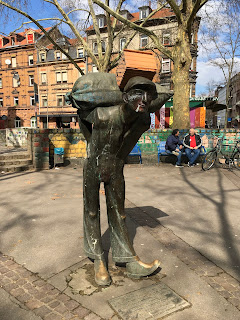This 25,000 seat Ampitheater, like most of the ancient walls and buildings was used as a quarry to build churches and houses in the Middle Ages.
But underneath one can still see where the entertainers and their props stayed before they popped up. They even used counter-weighted hoists to quickly appear and disappear.
In the surrounding walls one can imagine where they sold food and trinkets.
Eventually all the stone seats were removed and the hillsides became vinyards!
The Porta Nigra is the symbol of the city, one of the four huge gates that led into this walled Roman city. The wall was 4 miles long, and like all Roman buildings used no mortar - only iron pegs to hold the huge sandstone blocks together!

The archeological museum is a treasure! Literally....
In 1993 a construction worker broke this ancient container and saw gold Roman coins pour out!
The cathedral is impressive and has undergone many additions and changes through the centuries.
The relics in these European cathedrals are always interesting, if unbelievable. Here lies the garment Christ wore. It is kept in a bejeweled golden container, which is opened once a year, but serves as the center focus behind the altar every day.
We can't count how many churches we've visited in these 6 months. Everyone has been different and offered a moment of reflection.
Beside the Dom (cathedral) is the Basilica, a huge building, which was the imperial throne room for Constantin and today a Lutheran church.
The wooden ceiling blocks are 10ft square and are the exact relicas since the original ceiling and roof burned in WWII. Now the ceiling is supported by steel girders, but the original Roman ceiling was made of only wood!

Behind this archbishop's residence you see the Basilica. In the 12th C he attached his palace to it using the nave as a courtyard and the asp as a 5 story palace. All that was destroyed in WWII and what was left were the original Roman walls!
We accidently got off at a wrong bus stop and discovered the Barbara Baths, a huge complex of Roman bathing, which one can view by walking on a boardwalk above the ruins. Immense!
Trier is not only known as a Roman city, but also as the birthplace of Karl Marx. He lived here until he was finished with high school.
The Chinese gave the city a Karl Marx statue this year in honor of the 200 year celebration.
Ask us to see more fascinating pictures of Trier. Here we are at our Airbnb having a picnic outside. Wonderful trip!













































































